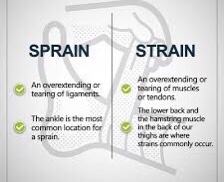Basic Questions Answered for Sprain & Strains by Dr. Neeraj Mehta (Ph.D. Human Biomechanics & Alternative Medicine)
There are two types of injuries that can result from overuse: sprains affect the ligaments or bands of tissue that connect two bones, and strains affect muscles or the band of tissue that attaches one muscle to an adjacent bone.
There are two types of injuries that can lead to an injury: sprain and strain.
As a sprain occurs, you may feel a tearing or popping sensation in the joint. If the joint is stiff or unstable, it will be difficult to move. When you strain a muscle, you may experience spasms or cramping in that particular area. Sprain and strain are more difficult to treat the more severe they are.
Muscle strains and pulls can be difficult to tell apart.
Swelling, bruising, or redness as a result of the injury are all symptoms of muscle strain.
Pain that is not actively being felt.
When a specific muscle or joint in relation to that muscle is activated, the resulting pain can be felt.
Resistance in the muscles and tendons.
Inability to use the muscle in any way whatsoever.
Does a strain heal faster than a sprain, or the other way around?
Sometimes, a strain is described as a “pulled muscle.” Though it may take a few weeks for muscle strain to heal, re-injury is possible. Whenever the ligaments (tissue bands that hold bones together in joints) stretch or tear, we call that an injury we call a sprain. Sprains usually take 4–6 weeks to heal, but they can take up to a month.
How can you tell if a sprain is severe?
Ankle sprains that are more severe than a mild strain should be treated by a doctor if the patient is unable to bear weight on the foot without significant pain.
A strained muscle can be treated in many ways.
For the first few days following an injury, apply ice to the strained muscle. Acetaminophen (Tylenol), an anti-inflammatory drug, can also help with swelling and pain reduction. Applying heat to the muscle will help ease the discomfort. Stretching and light exercises that increase blood flow to the injured area can also be beneficial in the long run.
Has a muscle been pulled?
When dealing with a muscle injury, the R.I.C.E. method is the first thing that should be used to treat it. During the first 72 hours, heat should be avoided to avoid swollen and inflamed skin. Once the first 72 hours have passed, heat can be added to the treatment to help the body’s natural healing process.
Is it true that drinking water can alleviate the pain of a sore muscle?
Physical therapy patients recovering from injury or surgery need to stay well hydrated to make the most of their sessions. When we drink water, we flush toxins from our bodies and replenish our cells with vital nutrients. Water also aids in temperature control and pH balance in the body. Muscle soreness and tension can also be alleviated by drinking water.
On one’s own, can a muscle tear be healed?
Resuming normal activities is possible once the patient has regained full range of motion and no pain is present. Tears of a moderate severity may necessitate physical therapy. Surgical repair can take months or even years to complete in cases where a severe tear has occurred. Keep in mind the adage, “Do not HARM.” in this case.


